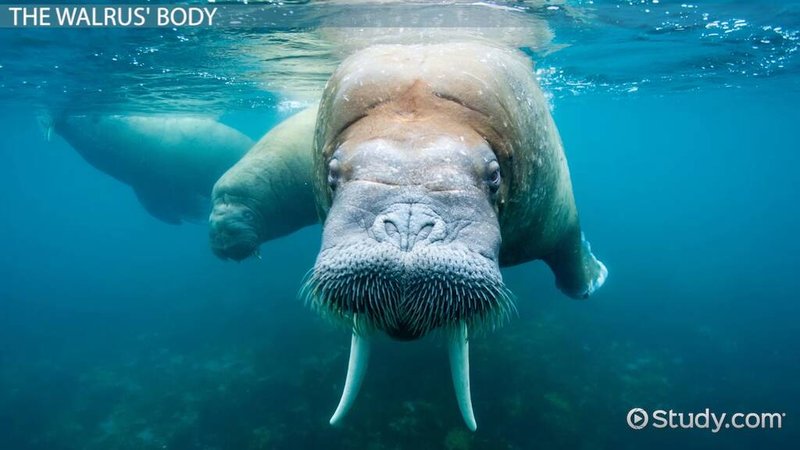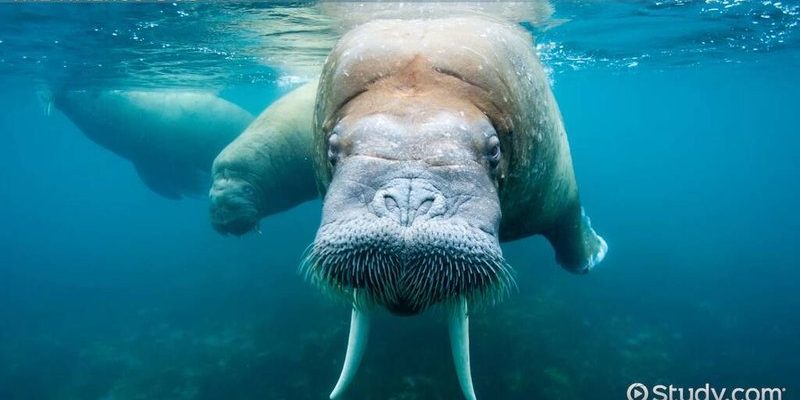
Walruses have developed several remarkable traits over time that help them hunt, stay warm, and navigate their underwater world. Imagine diving into water that’s often below freezing, where finding food can be a challenge. Walruses do this every day, thanks to their special features. Let’s dive in and explore the amazing adaptations that help these marine mammals not only survive but also flourish in their aquatic habitat.
Thick Blubber for Insulation
One of the walrus’s most impressive adaptations is its thick layer of blubber. This layer can be up to 6 inches thick and serves as a natural insulator against the icy waters of the Arctic. You might be wondering how something like blubber works. Well, while it might sound a bit gross, it’s actually a fantastic heat-retaining material. Think of it like a super cozy thermal blanket that keeps the walrus warm in freezing temperatures.
Blubber doesn’t just help with warmth; it also stores energy. When food is scarce, walruses can rely on this fat reserve. Imagine a time when you didn’t eat much but still felt full of energy—this is how walruses can sustain themselves during long periods without food. Their ability to maintain body heat and store energy is critical for survival.
During the breeding season, a walrus’s blubber becomes even more important. The males often battle for females, and having a thicker layer can give them an advantage. It’s like having a built-in armor that helps protect them from harsh conditions when they’re most active.
Large Tusks as Tools
If you’ve ever watched a walrus, you probably noticed those impressive tusks. They can grow up to three feet long and serve several important purposes. You might think of them as nature’s multi-tools! First, walruses use their tusks to help haul themselves out of the water and onto the ice. This is especially important because they often need to rest between dives. Picture a person trying to climb out of a pool—it can be tricky without something to grab onto.
Tusks also play a role in social interactions. Males use them to establish dominance during mating season. When two walruses face off, it’s like a show of strength and confidence! The bigger and stronger the tusks, the more likely they are to win a mate. This unique method of communication is crucial in their breeding rituals.
Finally, walruses use their tusks to help forage for food. They can poke around in the sediment on the ocean floor, stirring things up to find clams and other tasty treats. In this way, their tusks act like a shovel, making it easier for them to access meals and stay nourished.
Whiskers for Sensory Perception
Have you ever watched a cat or dog use its whiskers to sense the world around it? Walruses have a similar feature! Their whiskers, or vibrissae, are incredibly sensitive and help them navigate and find food underwater. Each whisker is packed with nerve endings, allowing them to pick up on subtle vibrations in the water.
When walruses dive, they lose sight of their surroundings due to murky water. That’s where the whiskers shine. Imagine trying to find your way in the dark, relying only on touch—this is what walruses do with their sensitive whiskers. They can detect the movement of prey and pinpoint exactly where to dive down to catch dinner.
This adaptation is especially helpful when hunting for clams, their primary food source. Walruses often use their whiskers to feel around the ocean floor and locate buried clams. It’s a remarkable ability that gives them an edge over other marine animals.
Powerful Flippers for Swimming
When you see a walrus in the water, it looks so graceful, almost like it’s floating along effortlessly. But don’t be fooled! Behind that sleek appearance are powerful flippers that help them swim and dive with agility. These flippers, which can be thought of as the walrus’s “arms and legs,” have strong muscles that allow for powerful strokes.
Walruses can swim quite fast, reaching speeds of up to 35 miles per hour in short bursts. They use their front flippers for steering and the back flippers for propulsion, giving them a full range of motion. Picture a swimmer who uses different strokes to navigate through the water—walruses do the same, adapting their movements based on what they need to do.
Additionally, their flippers help them maneuver around the ice. When they need to haul out onto the ice for rest or socializing, those strong flippers come in handy. They can push themselves up onto ice blocks, often using their tusks to help maintain balance. It’s a perfect illustration of how evolution has crafted these animals to thrive in their unique environment.
Coloration and Camouflage
From a distance, walruses might seem like large, blubbery creatures, but their coloration plays a vital role in their survival. Their skin can range from light beige to dark brown, making them less visible against the rocky ocean floor or ice. This natural camouflage helps them evade predators, like orcas or polar bears.
The color of a walrus can also change depending on temperature and environment. When they’re out of the water and basking in the sun, their skin can darken, providing better protection from the harmful rays. Think of it as a built-in sunscreen. This ability to adapt their coloration is one of those clever tricks nature has developed.
Moreover, when walruses are in deeper waters, their skin appears lighter, blending in with the surroundings. This adaptability helps them avoid detection not only from predators but also while hunting for food. It gives them a strategic advantage, allowing them to thrive in various conditions.
Enhanced Breathing Capabilities
Have you ever held your breath underwater for as long as you could? Walruses have some incredible adaptations when it comes to breathing! They can hold their breath for up to 30 minutes while diving for food, which is quite impressive for any animal. Their unique physiology allows them to use oxygen more efficiently, giving them longer dive times.
When a walrus dives, its heart rate slows down, conserving oxygen. This is similar to how some humans slow their breathing during relaxation or meditation. By reducing their heart rate, walruses can extend their time underwater, searching for clams and other delicacies without having to surface for air constantly.
Also, they have large lungs, which can store more air for longer dives. If you think of it as a balloon, the bigger the balloon, the more air it can hold. This ability allows walruses to venture deeper and forage more effectively, helping them find food sources even in challenging conditions.
Social Behavior and Communication
Walruses are not solitary creatures; they thrive in social groups known as herds. This behavior serves many purposes, from protection against predators to social interactions. Being in a group means more eyes to spot danger and more resources to find food. It’s like having a supportive community around you—everyone looks out for one another.
Communication is key in these social settings. Walruses have a range of sounds, from loud barks to softer grunts. These vocalizations help maintain group cohesion, especially during breeding season. Imagine a group of friends chatting to stay connected; it’s the same for walruses! Their social interactions also include physical displays, where they use their tusks and flippers for play and asserting dominance.
Being part of a herd can also help walruses when facing environmental challenges, like ice loss due to climate change. Together, they can adapt to changes more effectively. This sense of community plays a significant role in their overall survival in the harsh Arctic environment.
In summary, walruses are truly remarkable creatures that have adapted to thrive in underwater life. From their thick blubber and powerful flippers to their social behaviors and communication skills, each adaptation is a testament to nature’s creativity. So next time you see a walrus, remember that beneath that blubbery exterior lies a fascinating world of survival skills that keeps them thriving in one of the toughest environments on Earth.

